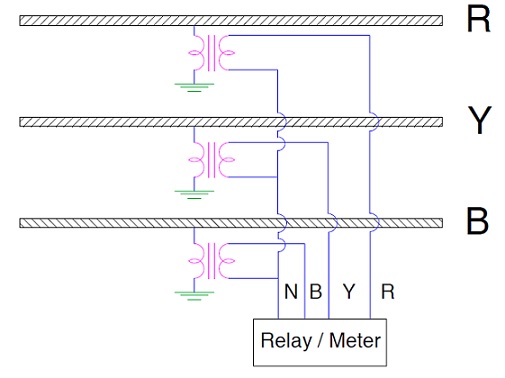Before discussing “Why PT/VT Secondary Terminal should not be Shorted?”, it is good to have a brief idea of Potential Transformers / Voltage Transformers. PTs/VTs are Instrument Transformer used for the purpose of protection and measurement. The construction of PT/VT is same as that of power transformer except for insulation level, cooling, sealing etc. PTs are designed for of specific voltage rating like 400 kV / 110 V. This means that when a PT primary is connected to 400 kV line, the secondary voltage will be 110 V. This secondary voltage is then connected to various measuring instruments like voltmeter, energy meter etc. and protection relays like distance relay, direction earth fault relay etc.
Thus we can say, PT steps down the primary line voltage to some lower voltage suitable for relays and meters. This means that PT design should be such that to have low voltage regulation to maintain its secondary voltage constant.
Why PT/VT Secondary Terminal should not be Shorted?
Let us now come to the point, why PT/VT Secondary Terminals should not be shorted? Unlike Current Transformer (CT), PTs are connected in line to ground as shown in figure below. Figure below depicts the connection of three PTs connected in three phases. Note that a neutral point is made by shorting a terminal of three PTs and then grounding the neutral point.
You may like to read Difference between Current Transformer & Potential Transformer
Due to low voltage regulation, the secondary terminal voltage will remain constant and hence if we keep the PT terminals open, nothing is going to happen as the secondary voltage is low (110 / 1.732 = 63.5V). Mind that the same is not true for CT. CT secondary terminals should never be kept open. In normal condition, PT secondary is connected to some impedance offered by relay / measuring instrument. Therefore the current through the secondary circuit is low.
But when we short the secondary of PT, a high current will flow thorough the secondary circuit. This is because of low voltage regulation. PT will try to maintain its secondary voltage and for doing this it will try to flow high current through shorted terminals. This high current will lead to overheating and consequent damage to the PT.
To avoid damage due to short circuit of PT terminals, fuses are installed in PT junction box. In case of short circuit of secondary terminals, these fuses will blow out and thus will open the circuit. It shall be noted that fuse should be installed as near to the PT as possible to avoid heating of connecting cables.

3.3kv pt got burnt . what will be the reason? This happened when primari got opened
I need more information to find the root cause.
Pt Secondary terminal cable insulation damage is one of the reasons.how to find then before charging do an IR test.That ir test during time connecting all Secondary cables without earth or neutral cables now do an primar to core ir test easy to find it.that is the way to find core to core or core to neutral short.
When the primary circuit is energized, explain why should never:
Keep Voltage Transformer (VT) secondary side as close circuit